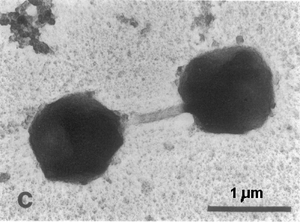Hyperthermus: Difference between revisions
No edit summary |
No edit summary |
||
| (28 intermediate revisions by 3 users not shown) | |||
| Line 1: | Line 1: | ||
{ | {{Curated}} | ||
{{Biorealm Genus}} | |||
[[image:hyperthermus.png|thumb|300px|right|Electron micrographs of ''H. butylicus''. Cells connected by a string of cytoplasm. From [http://jb.asm.org/cgi/reprint/172/7/3959 Zillig, W. et al. "''Hyperthermus butylicus'', a Hyperthermophilic Sulfur-Reducing Archaebacterium That Ferments Peptides." ''J. of Bacteriol.'' July, 1990. Vol. 172, No. 7. p. 3962.]]] | |||
[[image: hyperthermus.png|thumb|300px|right|Electron micrographs of H. butylicus. | |||
==Classification== | ==Classification== | ||
| Line 14: | Line 13: | ||
''Hyperthermus butylicus'' | ''Hyperthermus butylicus'' | ||
{| | |||
| height="10" bgcolor="#FFDF95" | | |||
'''NCBI: [http://www.ncbi.nlm.nih.gov/Taxonomy/Browser/wwwtax.cgi?id=54247 Taxonomy] Genome ''' | |||
|} | |||
==Description and significance== | ==Description and significance== | ||
''Hyperthermus'' is a hyperthermophilic, sulfur reducing archaeon that grows between 95 and 106°C and at pH of 7.0. Also, it forms H<sub>2</sub>S from elemental sulfur and molecular hydrogen as a growth-stimulating accessory energy source but not by sulfur respiration. Further, the archaeon has a characteristic smell which composes of H<sub>2</sub>S and butyl mercaptan and the odors of 1-butanol and phenylacetic acid. | |||
==Genome structure== | ==Genome structure== | ||
The genome of ''Hyperthermus'' has been completed by [http://www.hindawi.com/journals/arch/2007/745987.abs.html Brugger et al.] Its genome consists of a single circular chromosome of 1,667,163 bp with a 53.7% G+C content. A total of 1672 genes were annotated, of which 1602 are protein-coding, and up to a third are specific to <i>H. butylicus</i>. A relatively high level of GUG and UUG start codons are predicted. | |||
==Cell structure and metabolism== | ==Cell structure and metabolism== | ||
The cells of ''Hyperthermus'' are irregular spherical shape (around 1.5 µm in diameter) with edges between partially flattened surfaces. The ones that grow in higher temperature often contain vacuoles within their cytoplasm, sometimes immediately below the S layer. | |||
The archaeon acquires energy by fermenting peptides, including laboratory peptide mixtures (eg, Tryptone, Trypticase, Merck peptone from casein, gelatin, and a chymotryptic digest of casein) as carbon and energy sources. No growth has been observed with starch, maltose, sucrose, lactose, glucose, galactose, ribose, lactic acid, lactic acid ethylester, glyoxylate, pyruvate, oxalate, fumarate, maleate, malate, malonate, and formate. | |||
==Ecology== | ==Ecology== | ||
The strains of ''Hyperthermus butylicus'' were isolated from the sea floor of a hot, solfataric habitat on the coast of São Miguel Island in Azores, Portugal. With its ability to live at the temperature of 106°C, it is one of the most thermophilic archaea isolated so far. | |||
==References== | ==References== | ||
[http://www.hindawi.com/journals/arch/2007/745987.abs.html Brugger K, Chen L, Stark M, Zibat A, Redder P, et al.]."The genome of Hyperthermus butylicus: a sulfur-reducing, peptide fermenting, neutrophilic Crenarchaeote growing up to 108 degrees C." 2007. Archaea 2:127-135.<br> | |||
[http://www.ncbi.nlm.nih.gov/entrez/query.fcgi?cmd=Retrieve&db=PubMed&dopt=Abstract&list_uids=2113915 Zillig, W., Holz, I., Janekovic, D., Klenk, H., Imsel, E., Trent, J., Wunderl, S., Fojaz, V. H., Coutinho, R., and Ferreira, T."''Hyperthermus butylicus'', a Hyperthermophilic Sulfur-Reducing Archaebacterium That Ferments Peptides." ''Journal of Bacteriology''. | [http://www.ncbi.nlm.nih.gov/entrez/query.fcgi?cmd=Retrieve&db=PubMed&dopt=Abstract&list_uids=2113915 Zillig, W., Holz, I., Janekovic, D., Klenk, H., Imsel, E., Trent, J., Wunderl, S., Fojaz, V. H., Coutinho, R., and Ferreira, T."] 1990. ''Hyperthermus butylicus'', a Hyperthermophilic Sulfur-Reducing Archaebacterium That Ferments Peptides." ''Journal of Bacteriology''. 172:3959-3965. | ||
Latest revision as of 02:13, 12 August 2011
A Microbial Biorealm page on the genus Hyperthermus

Classification
Higher order taxa
Archaea; Crenarchaeota; Thermoprotei; Desulfurococcales; Pyrodictiaceae
Species
Hyperthermus butylicus
|
NCBI: Taxonomy Genome |
Description and significance
Hyperthermus is a hyperthermophilic, sulfur reducing archaeon that grows between 95 and 106°C and at pH of 7.0. Also, it forms H2S from elemental sulfur and molecular hydrogen as a growth-stimulating accessory energy source but not by sulfur respiration. Further, the archaeon has a characteristic smell which composes of H2S and butyl mercaptan and the odors of 1-butanol and phenylacetic acid.
Genome structure
The genome of Hyperthermus has been completed by Brugger et al. Its genome consists of a single circular chromosome of 1,667,163 bp with a 53.7% G+C content. A total of 1672 genes were annotated, of which 1602 are protein-coding, and up to a third are specific to H. butylicus. A relatively high level of GUG and UUG start codons are predicted.
Cell structure and metabolism
The cells of Hyperthermus are irregular spherical shape (around 1.5 µm in diameter) with edges between partially flattened surfaces. The ones that grow in higher temperature often contain vacuoles within their cytoplasm, sometimes immediately below the S layer. The archaeon acquires energy by fermenting peptides, including laboratory peptide mixtures (eg, Tryptone, Trypticase, Merck peptone from casein, gelatin, and a chymotryptic digest of casein) as carbon and energy sources. No growth has been observed with starch, maltose, sucrose, lactose, glucose, galactose, ribose, lactic acid, lactic acid ethylester, glyoxylate, pyruvate, oxalate, fumarate, maleate, malate, malonate, and formate.
Ecology
The strains of Hyperthermus butylicus were isolated from the sea floor of a hot, solfataric habitat on the coast of São Miguel Island in Azores, Portugal. With its ability to live at the temperature of 106°C, it is one of the most thermophilic archaea isolated so far.
References
Brugger K, Chen L, Stark M, Zibat A, Redder P, et al.."The genome of Hyperthermus butylicus: a sulfur-reducing, peptide fermenting, neutrophilic Crenarchaeote growing up to 108 degrees C." 2007. Archaea 2:127-135.
Zillig, W., Holz, I., Janekovic, D., Klenk, H., Imsel, E., Trent, J., Wunderl, S., Fojaz, V. H., Coutinho, R., and Ferreira, T." 1990. Hyperthermus butylicus, a Hyperthermophilic Sulfur-Reducing Archaebacterium That Ferments Peptides." Journal of Bacteriology. 172:3959-3965.
